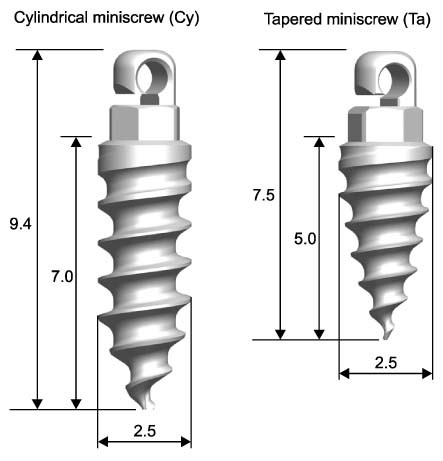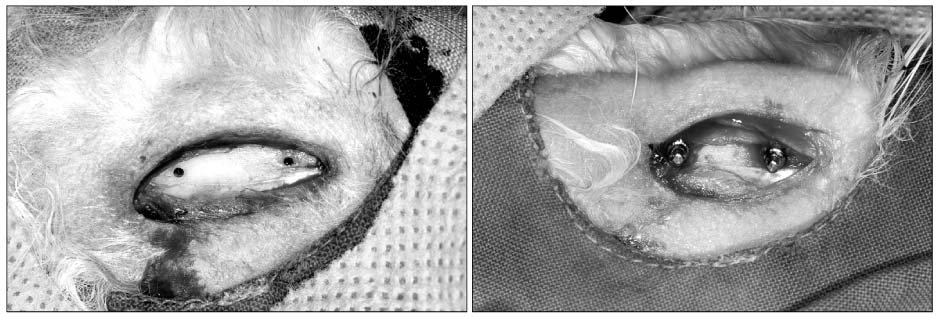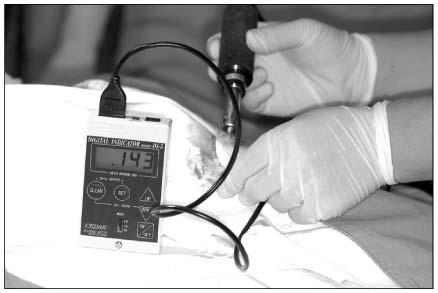Korean J Orthod.
2011 Aug;41(4):280-287. 10.4041/kjod.2011.41.4.280.
The comparison of torque values in two types of miniscrews placed in rabbits: tapered and cylindrical shapes: Preliminary study
- Affiliations
-
- 1Department of Orthodontics, Gangnam Severance Dental Hospital, Korea.
- 2Department of Conservative Dentistry, The Institute of Oral Health & Science, Samsung Medical Center, Sungkyunkwan University School of Medicine, Korea.
- 3Veterinarian, Samsung Biomedical Research Institue, Laboratory Animal Research Center, Korea.
- 4Department of Orthodontics, The Institute of Oral Health & Science, Samsung Medical Center, Sungkyunkwan University School of Medicine, Korea. shkyung@gmail.com
- KMID: 2274262
- DOI: http://doi.org/10.4041/kjod.2011.41.4.280
Abstract
OBJECTIVE
This study compared the stability of cylindrical miniscrews (Cy, 7 mm in length) with that of tapered miniscrews (Ta, 5 mm in length), using torque values to determine if the healing time before loading affects the stability of the miniscrew and if the insertion torque is associated with the removal torque measured after a few weeks of healing.
METHODS
Ta and Cy with different thread lengths were placed in the tibias of 12 female New Zealand white rabbits (body weight: 3.0 - 3.5 kg), and the maximum insertion torque values (ITV) were measured. No orthodontic forces were applied so as to allow us to determine the pure effects of the different shapes. After 3 different healing periods (2, 4, and 6 weeks), maximum removal torque values (RTV) were measured immediately before the rabbits were sacrificed.
RESULTS
No miniscrews were loosened. There were no significant differences in ITV or RTV between the Ta and Cy nor were there any significant differences in the ITV and RTV between the 3 groups, which had different healing periods. There was a correlation between the ITV and RTV.
CONCLUSIONS
Shorter Ta showed similar stability as Cy, as determined by torque values. This result strongly suggests that the tapered shape is more advantageous than the cylindrical shape. The RTV did not increase significantly over time. It is recommended that a miniscrew be loaded immediately; waiting a few weeks before loading should be avoided. The correlation between the ITV and RTV suggests that the ITV can be used to estimate a screw's future stability.
Keyword
Figure
Reference
-
1. Umemori M, Sugawara J, Mitani H, Nagasaka H, Kawamura H. Skeletal anchorage system for open-bite correction. Am J Orthod Dentofacial Orthop. 1999. 115:166–174.
Article2. Park HS, Kwon OW, Sung JH. Nonextraction treatment of an open bite with microscrew implant anchorage. Am J Orthod Dentofacial Orthop. 2006. 130:391–402.
Article3. Choi KJ, Choi JH, Lee SY, Ferguson DJ, Kyung SH. Facial improvements after molar intrusion with miniscrew anchorage. J Clin Orthod. 2007. 41:273–280.4. Sugawara J, Kanzaki R, Takahashi I, Nagasaka H, Nanda R. Distal movement of maxillary molars in nongrowing patients with the skeletal anchorage system. Am J Orthod Dentofacial Orthop. 2006. 129:723–733.
Article5. Kyung SH, Hong SG, Park YC. Distalization of maxillary molars with a midpalatal miniscrew. J Clin Orthod. 2003. 37:22–26.6. Kyung SH, Lee JY, Shin JW, Hong C, Dietz V, Gianelly AA. Distalization of the entire maxillary arch in an adult. Am J Orthod Dentofacial Orthop. 2009. 135:4 Suppl. S123–S132.
Article7. Petrie CS, Williams JL. Comparative evaluation of implant designs: influence of diameter, length, and taper on strains in the alveolar crest. A three-dimensional finite-element analysis. Clin Oral Implants Res. 2005. 16:486–494.
Article8. Renouard F, Nisand D. Impact of implant length and diameter on survival rates. Clin Oral Implants Res. 2006. 17:Suppl 2. 35–51.
Article9. O'Sullivan D, Sennerby L, Meredith N. Influence of implant taper on the primary and secondary stability of osseointegrated titanium implants. Clin Oral Implants Res. 2004. 15:474–480.10. Yano S, Motoyoshi M, Uemura M, Ono A, Shimizu N. Tapered orthodontic miniscrews induce bone-screw cohesion following immediate loading. Eur J Orthod. 2006. 28:541–546.
Article11. Motoyoshi M, Hirabayashi M, Uemura M, Shimizu N. Recommended placement torque when tightening an orthodontic mini-implant. Clin Oral Implants Res. 2006. 17:109–114.
Article12. Akkocaoglu M, Uysal S, Tekdemir I, Akca K, Cehreli MC. Implant design and intraosseous stability of immediately placed implants: a human cadaver study. Clin Oral Implants Res. 2005. 16:202–209.
Article13. Sakoh J, Wahlmann U, Stender E, Nat R, Al-Nawas B, Wagner W. Primary stability of a conical implant and a hybrid, cylindric screw-type implant in vitro. Int J Oral Maxillofac Implants. 2006. 21:560–566.14. Wilmes B, Rademacher C, Olthoff G, Drescher D. Parameters affecting primary stability of orthodontic mini-implants. J Orofac Orthop. 2006. 67:162–174.
Article15. Ueda M, Matsuki M, Jacobsson M, Tjellström A. Relationship between insertion torque and removal torque analyzed in fresh temporal bone. Int J Oral Maxillofac Implants. 1991. 6:442–447.16. Morais LS, Serra GG, Muller CA, Andrade LR, Palermo EF, Elias CN, et al. Titanium alloy mini-implants for orthodontic anchorage: immediate loading and metal ion release. Acta Biomater. 2007. 3:331–339.
Article17. Zhao L, Xu Z, Yang Z, Wei X, Tang T, Zhao Z. Orthodontic mini-implant stability in different healing times before loading: a microscopic computerized tomographic and biomechanical analysis. Oral Surg Oral Med Oral Pathol Oral Radiol Endod. 2009. 108:196–202.
Article18. Deguchi T, Takano-Yamamoto T, Kanomi R, Hartsfield JK Jr, Roberts WE, Garetto LP. The use of small titanium screws for orthodontic anchorage. J Dent Res. 2003. 82:377–381.
Article19. Luzi C, Verna C, Melsen B. A prospective clinical investigation of the failure rate of immediately loaded mini-implants used for orthodontic anchorage. Prog Orthod. 2007. 8:192–201.20. Woods PW, Buschang PH, Owens SE, Rossouw PE, Opperman LA. The effect of force, timing, and location on bone-to-implant contact of miniscrew implants. Eur J Orthod. 2009. 31:232–240.
Article21. Kuroda S, Sugawara Y, Deguchi T, Kyung HM, Takano-Yamamoto T. Clinical use of miniscrew implants as orthodontic anchorage: success rates and postoperative discomfort. Am J Orthod Dentofacial Orthop. 2007. 131:9–15.
Article22. Miyawaki S, Koyama I, Inoue M, Mishima K, Sugahara T, Takano-Yamamoto T. Factors associated with the stability of titanium screws placed in the posterior region for orthodontic anchorage. Am J Orthod Dentofacial Orthop. 2003. 124:373–378.
Article23. Park HS, Jeong SH, Kwon OW. Factors affecting the clinical success of screw implants used as orthodontic anchorage. Am J Orthod Dentofacial Orthop. 2006. 130:18–25.
Article24. Chen YJ, Chen YH, Lin LD, Yao CC. Removal torque of miniscrews used for orthodontic anchorage--a preliminary report. Int J Oral Maxillofac Implants. 2006. 21:283–289.25. Song YY, Cha JY, Hwang CJ. Mechanical characteristics of various orthodontic mini-screws in relation to artificial cortical bone thickness. Angle Orthod. 2007. 77:979–985.
Article26. Friberg B, Sennerby L, Roos J, Johansson P, Strid CG, Lekholm U. Evaluation of bonedensity using cutting resistance measurements and microradiography: an in vitro study in pig ribs. Clin Oral Implants Res. 1995. 6:164–171.
Article27. Ikumi N, Tsutsumi S. Assessment of correlation between computerized tomography values of the bone and cutting torque values at implant placement: a clinical study. Int J Oral Maxillofac Implants. 2005. 20:253–260.28. Niimi A, Ozeki K, Ueda M, Nakayama B. A comparative study of removal torque of endosseous implants in the fibula, iliac crest and scapula of cadavers: preliminary report. Clin Oral Implants Res. 1997. 8:286–289.
Article29. Beer A, Gahleitner A, Holm A, Tschabitscher M, Homolka P. Correlation of insertion torques with bone mineral density from dental quantitative CT in the mandible. Clin Oral Implants Res. 2003. 14:616–620.
Article30. Klokkevold PR, Johnson P, Dadgostari S, Caputo A, Davies JE, Nishimura RD. Early endosseous integration enhanced by dual acid etching of titanium: a torque removal study in the rabbit. Clin Oral Implants Res. 2001. 12:350–357.
Article31. da Cunha HA, Francischone CE, Filho HN, de Oliveira RC. A comparison between cutting torque and resonance frequency in the assessment of primary stability and final torque capacity of standard and TiUnite single-tooth implants under immediate loading. Int J Oral Maxillofac Implants. 2004. 19:578–585.32. Turkyilmaz I. A comparison between insertion torque and resonance frequency in the assessment of torque capacity and primary stability of Brånemark system implants. J Oral Rehabil. 2006. 33:754–759.
Article33. Lim SA, Cha JY, Hwang CJ. Insertion torque of orthodontic miniscrews according to changes in shape, diameter and length. Angle Orthod. 2008. 78:234–240.
Article34. Morarend C, Qian F, Marshall SD, Southard KA, Grosland NM, Morgan TA, et al. Effect of screw diameter on orthodontic skeletal anchorage. Am J Orthod Dentofacial Orthop. 2009. 136:224–229.
Article35. Mortensen MG, Buschang PH, Oliver DR, Kyung HM, Behrents RG. Stability of immediately loaded 3- and 6-mm miniscrew implants in beagle dogs--a pilot study. Am J Orthod Dentofacial Orthop. 2009. 136:251–259.
Article36. Simon H, Caputo AA. Removal torque of immediately loaded transitional endosseous implants in human subjects. Int J Oral Maxillofac Implants. 2002. 17:839–845.37. Roberts WE, Smith RK, Zilberman Y, Mozsary PG, Smith RS. Osseous adaptation to continuous loading of rigid endosseous implants. Am J Orthod. 1984. 86:95–111.
Article38. Freire JN, Silva NR, Gil JN, Magini RS, Coelho PG. Histomorphologic and histomophometric evaluation of immediately and early loaded mini-implants for orthodontic anchorage. Am J Orthod Dentofacial Orthop. 2007. 131:704.e1–704.e9.
Article39. Meredith N, Book K, Friberg B, Jemt T, Sennerby L. Resonance frequency measurements of implant stability in vivo. A cross-sectional and longitudinal study of resonance frequency measurements on implants in the edentulous and partially dentate maxilla. Clin Oral Implants Res. 1997. 8:226–233.
Article40. Meredith N. Assessment of implant stability as a prognostic determinant. Int J Prosthodont. 1998. 11:491–501.41. Veltri M, Balleri B, Goracci C, Giorgetti R, Balleri P, Ferrari M. Soft bone primary stability of 3 different miniscrews for orthodontic anchorage: a resonance frequency investigation. Am J Orthod Dentofacial Orthop. 2009. 135:642–648.
Article42. Meredith N, Alleyne D, Cawley P. Quantitative determination of the stability of the implant-tissue interface using resonance frequency analysis. Clin Oral Implants Res. 1996. 7:261–267.
Article43. Okuyama K, Abe E, Suzuki T, Tamura Y, Chiba M, Sato K. Can insertional torque predict screw loosening and related failures? An in vivo study of pedicle screw fixation augmenting posterior lumbar interbody fusion. Spine (Phila Pa 1976). 2000. 25:858–864.44. Ottoni JM, Oliveira ZF, Mansini R, Cabral AM. Correlation between placement torque and survival of single-tooth implants. Int J Oral Maxillofac Implants. 2005. 20:769–776.
- Full Text Links
- Actions
-
Cited
- CITED
-
- Close
- Share
- Similar articles
-
- Comparison of insertion torque regarding changes in shape, diameter, and length of orthodontic miniscrews
- Influence of immediate loading on the removal torque value of mini-screws
- Stress distributions in peri-miniscrew areas from cylindrical and tapered miniscrews inserted at different angles
- Removal torque and bone formation of orthodontic miniscrew implant
- Mechanical analysis of the taper shape and length of orthodontic mini-implant for initial stability





